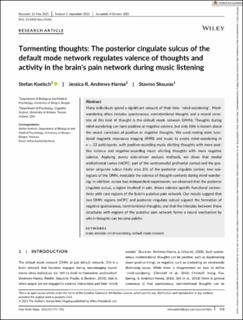| dc.contributor.author | Koelsch, Stefan | |
| dc.contributor.author | Andrews-Hanna, Jessica R. | |
| dc.contributor.author | Skouras, Stavros | |
| dc.date.accessioned | 2023-03-08T12:42:57Z | |
| dc.date.available | 2023-03-08T12:42:57Z | |
| dc.date.created | 2022-05-06T12:12:58Z | |
| dc.date.issued | 2022 | |
| dc.identifier.issn | 1065-9471 | |
| dc.identifier.uri | https://hdl.handle.net/11250/3057077 | |
| dc.description.abstract | Many individuals spend a significant amount of their time “mind-wandering”. Mind-wandering often includes spontaneous, nonintentional thought, and a neural correlate of this kind of thought is the default mode network (DMN). Thoughts during mind-wandering can have positive or negative valence, but only little is known about the neural correlates of positive or negative thoughts. We used resting-state functional magnetic resonance imaging (fMRI) and music to evoke mind-wandering in n = 33 participants, with positive-sounding music eliciting thoughts with more positive valence and negative-sounding music eliciting thoughts with more negative valence. Applying purely data-driven analysis methods, we show that medial orbitofrontal cortex (mOFC, part of the ventromedial prefrontal cortex) and the posterior cingulate sulcus (likely area 23c of the posterior cingulate cortex), two sub-regions of the DMN, modulate the valence of thought-contents during mind-wandering. In addition, across two independent experiments, we observed that the posterior cingulate sulcus, a region involved in pain, shows valence-specific functional connectivity with core regions of the brain's putative pain network. Our results suggest that two DMN regions (mOFC and posterior cingulate sulcus) support the formation of negative spontaneous, nonintentional thoughts, and that the interplay between these structures with regions of the putative pain network forms a neural mechanism by which thoughts can become painful. | en_US |
| dc.language.iso | eng | en_US |
| dc.publisher | Wiley | en_US |
| dc.rights | Navngivelse 4.0 Internasjonal | * |
| dc.rights.uri | http://creativecommons.org/licenses/by/4.0/deed.no | * |
| dc.title | Tormenting thoughts: The posterior cingulate sulcus of the default mode network regulates valence of thoughts and activity in the brain's pain network during music listening | en_US |
| dc.type | Journal article | en_US |
| dc.type | Peer reviewed | en_US |
| dc.description.version | publishedVersion | en_US |
| dc.rights.holder | Copyright 2021 The Author(s) | en_US |
| cristin.ispublished | true | |
| cristin.fulltext | original | |
| cristin.qualitycode | 2 | |
| dc.identifier.doi | 10.1002/hbm.25686 | |
| dc.identifier.cristin | 2022054 | |
| dc.source.journal | Human Brain Mapping | en_US |
| dc.source.pagenumber | 773-786 | en_US |
| dc.identifier.citation | Human Brain Mapping. 2022, 43 (2), 773-786. | en_US |
| dc.source.volume | 43 | en_US |
| dc.source.issue | 2 | en_US |

